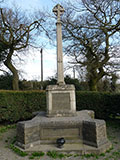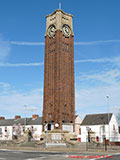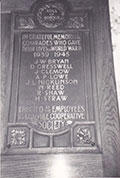Private William Thomas Mace, 24999
- Batt - 1
- Unit - Leicestershire Regiment
- Section -
- Date of Birth -
- Died - 15/09/1916
- Age -
Add to this record?
If you have photographs, documents or information that can contribute to this record, you can upload here
ContributeSource: Michael Doyle Their Name Liveth For Evermore: The Great War Roll of Honour for Leicestershire and Rutland. William lost his life in the attack on the strongly fortified Quadrilateral Redoubt that commenced at 6.20am on the 15th September 1916. The War Diary records that the Battalion moved into its attack position during the night and were finally settled down and ready to attack by 4.30am. 2nd Lieutenant Davis attached Q 6th Division. The Commanding Officer decided to attack with D and B Company’s in the front line, with D on the left and B on the right. A and C Company’s formed the second line, with A on the left and C on the right. Two Lewis Guns accompanied each Company, and two were left in reserve with Battalion HQ. Two Bombing Squads of ten each were also formed in each Company. These squads carried the full amount of bombs, while every man also carried two Mills No.5 bombs (one in each pocket). The fighting strength of the Battalion going into action was 23 officers including (the M.O. and Chaplain) and 643 other ranks. About 5.50am. two enemy aeroplanes appeared above us, but did not stay long. About this time also, a Tank was noticed on our right moving quietly up to the enemy’s front line. On arriving there he immediately opened fire with his machine guns, enfilading the German trench on either side. He was very heavily fired on by the enemy’s machine guns which apparently had no effect as he still continued his movements and firing. Nothing further happened till ZERO (6.20am.) when the attack commenced. The leading Company’s at once advanced at the walk in from lines 30X entrance between lines. A heavy machine gun fire was immediately opened by the enemy from about T.15 b 0.4. The Support Company’s followed on in the same formation 300X in the rear of the last wave of the leading Company. Battalion HQ’s moved immediately in the rear of the last wave of Support Company’s. The mist and smoke was terribly thick, and allowed no observation by the Support Company’s and Battalion HQ’s as to what was exactly happening to the leading Company’s. Owing to this (mist and smoke) a slight error occurred in direction. The right and left under orders to keep in touch with units attacking on our right and left, moved with these units thereby causing a small gap near our centre. This was immediately filled up by Support Company’s. The Artillery barrage opened too late to do any harm as the whole of the Supports had crossed the road moving due south from Ginchy (the place where the barrage was directed) before the barrage commenced. Battalion HQ’s had by this time moved into a shell hole about T.14 b 7.4. Throughout the advance the Battalion suffered very heavily from Machine Gun fire. The Battalion had not gained its objective line held up by very heavy fire, and the very strong and undamaged wire of the trench leading from the north west corner of the Left Quadrilateral (a strong point hitherto unknown). A Company immediately entrenched itself on a small ridge about T.14 b 9.6 to T.14 b 8.2, Efforts were made to locate the exact positions of B, C and D Company’s. It was found that B and C were entrenched about T.14 b 7.7 had lost very heavily while unsupported. D Company had lost very heavily also and the remainder (D Company) were still advancing with the Guards and occupying shell holes between our new position and the German wire ( a few of the latter came in under the cover of darkness). Good communication was kept with the contact aeroplane by means of flares and groundsheets throughout the day. Great difficulties were experienced in keeping track with Brigade HQ’s owing to the impossibility of using means of wired signalling, and the heavy barrage kept up throughout the day making it impossible for a runner to succeed in getting through. And then later Private Parry (A Company) did excellent work in getting through and returning safely to us, thus three times saving the day, he was finally detained by Brigade HQ’s after a fourth journey. Throughout the day the trenches were improved, and by night everyone had more or less good cover. A Company, B Company and HQ’s were subjected to heavy shell fire throughout the day. B and C Company were moved up to where our new line was continued to the right and left. The night was quiet except for heavy sniping in front of C Company and its attack on one line of trenches and a communication trench (in course of construction) line carried without any serious opposition. These were occupied by the 9th Bavarian Regiment. No prisoners were taken. Casualties, 2nd Lieutenant J. C. Webb, 2nd Lieutenant J. G. Kennedy and Lieutenant A. H. Pinder were all killed. 2nd Lieutenant F. B. Stevenson, Captain H. Pickbourne, 2nd Lieutenant H. A. Graves, 2nd Lieutenant W. Blacklock, Captain G. H. Salmon, Lieutenant J. H. John and 2nd Lieutenant R. Pickersgill were all wounded. Captain C. W. Herbison, 2nd Lieutenant G. H. Gristwood, 2nd Lieutenant J. Burnett and 2nd Lieutenant J. G. Gardner were all wounded and subsequently died. Other Ranks, A Company 23, B Company 35, C Company 23 and D Company 27 were killed. A Company 36, B Company 69, C. Company 56 and D Company 60 were wounded. A Company 5, B Company 11, C Company nil and D Company 16 missing in action.
Source: Leicestershire War Memorials Project. William Thomas MACE-Leicestershire Regiment, 1st Battalion.
Biographical information supplied by F. Tilley April 2016
William Thomas was born in 1890 in Todenham in Gloucestershire, the son of Charles and Emily Mace. Before the outbreak of war, William was living in Bardon Hill and worked at Bardon Quarry. He volunteered to join the Force and enlisted with the Army in Coalville, Leicestershire, possibly late 1914. It was said that he probably trained first with the 6th, 7th, 8th and 9th Battalion of the Leicestershire Regiment, but was transferred to the 1st Battalion following the number of casualties at the time. It is possible that William joined the 1st Battalion in the autumn of 1915.
William was killed in action on the 15th September 1916, at the age of 26. He was awarded the Victory Medal and the British Medal.
Coalville Times article - Friday January 31st, 1919
COALVILLE CO-OPERATIVE SOCIETY
EMPLOYEE’S ROLL OF HONOUR
The 140th quarterly meeting of the Coalville Workingmen’s Co-Operative Society was held in the Adult School Hall on Saturday evening, Mr C. W. Brown, jnr. presiding over a good attendance.
The chairman said it was the first time since he had been chairman that he had been able to wish the members a happy new year, except with bated breath. They were glad that peace was at hand. The war had made many homes sad and they all hoped that at the peace conference now sitting some method would be arrived at in dealing with disputes between nations which would prevent anything of the kind happen again (hear, hear).
A letter was read from Mr W. Stacey, thanking the members for their vote of sympathy with him on the death of his son.
The chairman said that it had been remarked that the Society had made many appeals to the local Tribunal, but it was not generally known that 85 of their employees had joined the Forces. He regretted to say that ten had made the supreme sacrifice, their names being:
J. Horrocks (boot department), E. Stinchcombe, W. Mace (stables), J. Brooks (Bagworth grocery), V. Hancox, W. Tyers (Ellistown grocery), D. Drinkwater (Central bakery), W. Collier (Hugglescote grocery), R. Brooks (butchery), and T. Wild (tailoring).
Coalville Times article - Friday July 18th, 1919
COALVILLE SOLDIERS WELCOMED
The employees of the Coalville Co-Operative Society organised a garden party on Wednesday as a welcome home to their fellow employees who have been serving in the Forces. A company of about 250 were taken by motor ‘bus to the Barrow Hill Farm, Osgathorpe, recently purchased by the Society, and there had tea and games, a pleasant time being spent. The Coalville Coronation Band was present. Of the 83 employees who served in the Forces, 7 were killed. The number recently returned and who were welcomed on Wednesday, was 42. Mr W. Scaysbrook (chairman) read the following to the assembly:
“Coalville Workingmen’s Co-Operative Society. – The primary object of our gathering to-day is to afford the opportunity of welcoming back to our midst those of our fellow employees and comrades who, responding to the call of duty, have endured danger and hardships in order that civilisation might be protected from the ravages of a ruthless foe, and in order that life for all nations shall be more worth living. The Society, with which we are associated, has made its contribution to the common cause, no less than 83 of its employees having joined the military, naval and air forces. To all who have been spared to return, we to-day give a whole-hearted “welcome home,” and at the same time express our deep appreciation of the services they have rendered, and our gratitude for having taken their part in protecting our hearths and homes. To all those who are still in service, we wish a speedy return to the more peaceful pursuits of our movement, so that they, with us, may help forward the day of the Co-Operative commonwealth. At a time like this we cannot forget, and we would not if we could, those of our number who have made the supreme sacrifice of their lives, and once again offer our deepest sympathy with all those who, through the tragedy of war, have lost those who were dear to them. Their names are:
J. W. Brooks, W. Brooks, W. Mace, T. Wild, R. Stinchcombe, W. Collier, R. Brooks, W. Tyers, V. Hancock, J. Horrocks and D. Drinkwater.
In conclusion we venture to express the earnest hope that never again shall you be called upon to leave your homes to engage in warfare, but trust that your future may be peaceful and prosperous, and worthy the sacrifices that have been made. – July 16th, 1919.”
Research undertaken and submitted by Andy Murby 20/07/2018
- Conflict - World War I
- Cause of death - KILLED IN ACTION
- Burial Place - Xi U 1, Guards' Cemetery, Lesboeufs
- Other Memorials - Coalville War Memorial Clock Tower
- Unit - Leicestershire Regiment
- Cause of death - KILLED IN ACTION
- Burial Commemoration - Guards' Cem., Les Boeufs, France
- Born - Todenham, Gloucestershire
- Enlisted - Coalville, Leicestershire
- Place of Residence - Bardon Hill, Leicestershire, England
- Memorial - ST. PETERS CHYRD. MEM., BARDON HILL, LEICS
- Memorial - CLOCK TOWER MEM., COALVILLE, LEICS
- Memorial - COUNCIL OFFICE MEM., COALVILLE, LEICS



